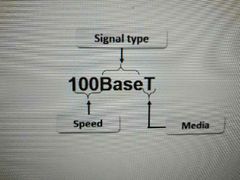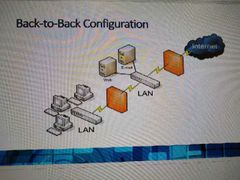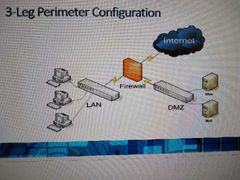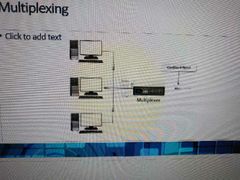![]()
![]()
![]()
Use LEFT and RIGHT arrow keys to navigate between flashcards;
Use UP and DOWN arrow keys to flip the card;
H to show hint;
A reads text to speech;
96 Cards in this Set
- Front
- Back
|
Network Characteristics (6) |
Simple Fair Reliable Robust Transparent Manageable |
|
|
Advantages of Network |
Vendors Connected Share Resources Addition/Removal Access Security Time Date Stamps Simple Back-Up High Speeds |
|
|
Nodes |
- An electrical device that is part of a network - Capable of creating, receiving or transmitting information |
|
|
Hosts |
- Devices on a network with their own IP addresses - Printers, Computers, Servers, Routers |
|
|
Peer Devices |
- Computers that act as both client and server |
|
|
Mainframe Computers |
- Analysing data traffic - Transaction Processing - Large organisations - Huge storage options |
|
|
Terminals |
- Simple computers that represent a mainframe in digital form |
|
|
Network Segments |
- Routers create them - Makes a group of devices into its own categories |
|
|
Network Backbone |
- The first line of contact from ISP to server, router, computer - Carrying internet traffic to devices |
|
|
LAN |
- Local Area Network - A network confined from one room to an entire building (small geographic location) - Cabled and wireless devices connected to a medium (router or server etc.) |
|
|
Why have LANs |
- Sharing info locally - Communication - Organisation - Profit |
|
|
Network Documentation |
- Something that defines or describes the current network infrastructure - Microsoft Visio is an example |
|
|
Hub |
- Central connection for devices - All hosts are connected through copper cabling - All data being sent, goes through the hub and is broadcast on every port |
|
|
Limitations of Hub |
- Half-Duplex - All data will be broadcast out all ports - Collisions and Broadcast Storm |
|
|
4 Port Router |
- Central connecting device - Special communications link to the internet - Allowing the host to send data to and receive from devices - Link between Router and internet is where a LAN ends |
|
|
Switches |
- Switch will recognise frames and pays attention to destination MAC address - Learns on which port packets are received - Does not broadcast its information to any other device |
|
|
How Do Switches Function |
- Learns on which port information arrives - Makes record in switching table and works keeps associated MAC address |
|
|
Managed vs Unmanaged Switch |
Managed: - Allows users to configure: - Duplex, Speed, QoS - More expensive Unmanaged: - Everything is already fully automated - If it stops working very difficult to fix again |
|
|
Speed + Duplex |
- 10/100/1000 - New Switches are still backwards compatible but older ones will not work |
|
|
Speed + Duplex Unmanaged Switch |
- Unmanaged will detect what speed is coming through the port and set the port to that speed - Half-Duplex data transfer |
|
|
Speed + Duplex Managed Switch |
- Speed set manually depending on model - Duplex can be set manually as well, it is not limited to half duplex |
|
|
5 Switching States |
Listening Learning Forwarding Blocking Disabled |
|
|
Switches Listening |
- Builds active topology - Listens to switch ID and MAC Address |
|
|
Learning |
- Begins building tables - The port cannot forward data currently |
|
|
Forwarding |
- Sending and receiving data - Port performs normal operations |
|
|
Blocking |
- A port that would cause a loop if it were sending data, so it only receives, removes the possibility of a loop |
|
|
Disabled |
- A port that is manually isolated from the network |
|
|
Single Collision Domain |
- Network that has packet collisions - Two devices send a packet at the same time, reducing network efficiency - Hub environment same collision domain - Switch or router are in a separate collision domain |
|
|
Broadcast Domain |
- Domain in which a broadcast is forwarded - Broadcast domain contains all devices that can reach eachother by the data link layer OSI Layer 2 |
|
|
Broadcast Domain Switch |
- A switch makes all of its ports part of the same Broadcast Domain |
|
|
Broadcast Domain Router |
- All ports on a router are in different broadcast domains |
|
|
Network Adapter |
- NIC (Network Interface Card), allowing you to send and receive data from your device
|
|
|
RJ-45 Patch Cable |
- This port will allow the most common wired connections to be accessible by that device |
|
|
Serial Data Transfer |
- Data is transferred to LAN in a serial fashion over twisted-pair cabling - Serial data transfer is a single-bit stream (one at a time) |
|
|
Serial Data Transmission Speed |
- Bits are transmitted one per clock cycle - Single bits across a single transmission medium |
|
|
Serial Data Transmission Data Throughput Is Limited 3 Types of Bits |
- Synchronisation bits - Start and Stop bits - Error Correction bits |
|
|
Serial Data Transmission Types of Communication |
- Synchronous and Asynchronous communication - Used in Ethernet networks |
|
|
Serial Data Transmission Devices |
- Keyboards - Mice - Modems - Other Devices |
|
|
Parallel Data Transmission Speed |
- Multiple bits are transmitted per clock cycle - Bits move across multiple transmission media |
|
|
Parallel Data Transmission Data Movement |
- Data throughout improved because non-data bits do not travel with data bits |
|
|
Parallel Data Transmission Uses + Devices |
- Printers + Scanners - PC System Bus - SCSI Data Bus - PC Card Bus |
|
|
Ethernet |
- The set of rules that govern transmission of data between network adapters - All network adapters and central devices must all use Ethernet cables to communicate |
|
|
Types of Ethernet |
- 802.3u Fast Ethernet that runs at 100Mbps - 802.3 or a Gigabit Ethernet
|
|
|
All Types of Transfers |
- Broadcast - Unicast - Multicast - Anycast |
|
|
Broadcast |
- All data is sent to all hosts on the network |
|
|
Unicast |
- Sends data to only one host |
|
|
Multicast |
- Data sent to all members of multicast group |
|
|
Anycast |
- Anycast sends data to nearest group member, which then forwards it to others in the network |
|
|
Broadcast Transmission |
- All Nodes receive the data that one computer has sent to the server |
|
|
Unicast Transmission |
- Node sends data to server, all other clients ignore this transmission |
|
|
Multicast Transmission |
- Server sends transmission to multicast group all of which receive the data - Other hosts outside the group ignore this transmission |
|
|
Anycast Transmission |
- Server sends transmission to nearest group member, the receiving computer will send it to its nearest group member |
|
|
Data Transfer Rate |
- Bit rate, defines how many bits per second transfer over a network - 10Mbps (Lower case b) bits - 10MB stored data for bytes (Capital B) |
|
|
10Base Standards |

100BaseT 100 is speed Base is signal type Media is the method / cable anything T is copper G is fiber optic |
|
|
Baseband Transmission |
- Near 0 frequency range - Digital Signalling - Uses all of the available bandwidth |
|
|
Broadband Transmission |
- Uses more than one frequency (FDM) - Frequency-Division Multiplexing - Analogue Signals - Shares available bandwidth |
|
|
IP Addresses |
- This address allows each device to send and receive information to eachother - Defines the device and the network it lives on |
|
|
IP Address Makeup |
- Split into 2 parts the network portion 192.168.2(first 3 octets) - While the final number dictates the host number |
|
|
Subnet Mask |
- A group of 4 numbers that defines what IP network the computer is a member of |
|
|
Host Devices IP Addresses |
- On most computers come from a network adapter - While switches and routers also have their own |
|
|
Wired LAN |
- Devices connected by copper based twisted-pair cables - STP or UTP |
|
|
WLAN |
- Wireless Local Area Network - Access point that is mobile and can connect other wirelessly connected devices |
|
|
WAP |
- Central connecting device of the network - Phones, Laptops, many other devices all can access wireless |
|
|
Virtual LAN |
- Group of hosts with a common set of requirements that communicate as if all of them were part of one switch despite physical location |
|
|
Perimeter Network |
- DMZ (Demilitarised Zone) - Set up seperateley from a companys private LAN and the internet |
|
|
Back-to-back Configuration |

- There are firewalls separating the DMZ from an organisations LAN - More secure way to protect against hacking |
|
|
3 Leg Perimeter |

- One firewall between the DMZ and an organisations LAN |
|
|
All Types of Topologies |
- Star - Token Ring - Mesh - Ring |
|
|
Star Topology |
- One central device is connected too by all other devices |
|
|
Mesh Topology |
- Makes up the internet - Every computer connects to all other computers on the network so it will likely take the fastest route possible |
|
|
Ring Topology |
- LAN Environment each computer connected in a loop - FDDI Fiber Distributed Data Interface |
|
|
Token Ring |
- A token goes from each computer and continues in a cycle, this will ask the computer if they are sending anything then move onto the next one |
|
|
Frames |
- A group of bytes packaged by a network adapter - These are created and move in Layer 2 of the OSI model |
|
|
Ethernet Standards High or Low |
10Mbps is 802.3 or 802.3a with 1 letter Gbps or higher is 802.3 followed by two letters |
|
|
Types of Media Access |
- Central device determines media access (speed of network data transfer) |
|
|
Polling - Controlled Media |
- Each device is contacted - Each node is guaranteed media access |
|
|
Polling - Demand Priority |
- Node Signal: - Ready to transmit - Idle - High priority |
|
|
Contention (First Come First Served) |
- CSMA/CD and CSMA/CA |
|
|
IEEE 802.3 |
CSMA/CD : Wired CSMA/CA : Wirelesa |
|
|
CSMA/CA Classroom |
- Check if anyone is transmitting, if a device set a timer to try again - Used for wireless communication due to inability to send and receive on the same channel |
|
|
CSMA/CD Chat Room |
- Checks if transmissions are not being sent, to send new transmission - If collision is detected timer set to send it again - Used in wired communications |
|
|
Token Passing |
- Token is a signal that gives the node permission to communicate - Collisions are eliminated in this scenario and bandwidth fully utilised - If computers want many short tasks they will have to wait for the token |
|
|
Token Bus |
- Virtual ring ( not actually shaped in a ring) - Each computer knows the address of its neighbour in the ring - Protocol 802.4 standard |
|
|
Multiplexing |

|
|
|
Centralised Computing |
- The older type of computing - Where there was one super computer and the rest were terminals - Terminals were just keyboards with a display |
|
|
Distributive Computing |
- Every device or workstation has its own processing power |
|
|
Terminal Services and Remote Sessions |
- Thin-client computers do not have a hard drive and store an operating system and RAM - Blending both forms of computing together |
|
|
Client Server Model |
- Architecture that distributes applications between servers - Windows Server 2016 |
|
|
Client Server Networks |
- Server provides: - Processing power - Management Services - Administrative Function |
|
|
Different Types of Servers |
- File Server - Print Server - Database Server - Network Controller - Messaging Server - Web Server - CTI (Computer Telephone Integration) |
|
|
Tower |
Smaller servers ideal for an office or smaller environment Can be easily upgraded and modified, and still can do always-on operation |
|
|
Rack Mount |
Rack Server designed to be installed into server cabinets for high density computing 1U up to 5U |
|
|
Blade Servers |
Blade Servers offer high density mounting of devices They are easy to maintain and can still grow with to suit business needs |
|
|
Peer-to-peer Networking |
Each computer is treated as an equal Some computers can also provide services to a small group of computers |
|
|
Peer-to-Peer Networks |
- Resourcing sharing, processing, and communications control |
|
|
P2P |
- These now refer to file sharing networks - Applications like Skype and Spotify |

